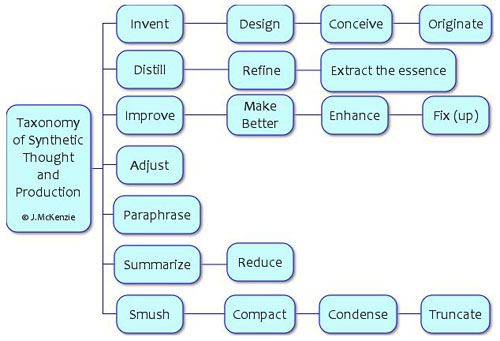
fno.org
|
|
| Vol 18|No 5|May 2009 | |
| Please feel free to e-mail this article to a friend, a principal, a parent, a colleague, a teacher librarian, a college professor, a poet, a magician, a vendor, an artist, a juggler, a student, a news reporter or to anyone else you think might enjoy it. | |
A Taxonomy
By Jamie McKenzie, ©2009, all rights reserved. |
 |
|
Why a taxonomy? Not all synthesis requires thought, originality or imagination. The mere act of squishing a bunch of information together — smooshing or smushing or compacting a heap of facts — is low grade synthesis. It requires little thought. The creation of a poem, a garden, a symphony or a good bottle of wine is quite a different matter. A taxonomy provides clarity about levels of challenge and value - as with the taxonomies created by Bloom for Affective and Cognitive domains. By alerting teachers and students to these levels, we hope to inspire production at a high level of originality and creativity.
Another Brick in the Wall When students do little more than scoop up information - all that is required by most topical research assignments - they are simply putting more bricks in the wall. There is little thought required. The long term implications for the society are vividly portrayed in this video of the Pink Floyd song on YouTube.
The bottom of the Taxonomy is much like the bottom of Bloom's Cognitive Taxonomy. Little thought is required. Little challenge is involved. While we expect students to master these levels, they should serve a higher purpose. If students remain captive to these levels, they will not make good citizens, employees or parents. The health of a society and an economy in this Age of Information depends upon the capacity of citizens to come up with original ideas, solutions and inventions. When these capabilities are in short supply, the vitality of the society will be compromised. An Originality Chorus Many organizations are now calling for original thinking. Educational groups in New Zealand, Australia and the States are stressing synthesis in a series of documents. New Zealand's Curriculum expects that students will become thinkers:
States in Australia have also made this kind of thinking a priority. Queensland, for example, has stressed decision-making, problem-solving and creating in its document outlining Essential Learnings for Studies of Society & Environment (SOSE) by the end of Year Nine:
In the States, three groups have issued a clear call for originality. AASL (The American Association of School Librarians) issued Standards for the 21st Century Learner that included clear statements such as the following:
ISTE (The International Society for Technology in Education) has also issued Standards that emphasize the importance of original thought and production:
Finally, The Partnership for 21st Century Skills, a group of high tech companies and educators, stresses creative and innovative production in its standards:
At a time when many governments are obsessed with high stakes testing and accountability schemes, it is heartening (while somewhat confusing) to hear this chorus of groups calling for a more creative approach to education than is normally measured or valued by the kinds of tests used by fans of accountability. The Top Levels of the Taxonomy Unlike most taxonomies, this one requires little explanation. A quick glance allows the reader to grasp the difference between top and bottom. The tasks and words selected to describe the levels are intentionally user-friendly and easy to grasp. A key aspect of the top levels would be novelty. Merely rearranging the elements of someone else's idea or product does not qualify for the top levels. The top levels demand freshness and imagination. Production and performance should inspire "oohs and ahhs." "Originate" is an awesome word. Its location at the pinnacle of the Taxonomy clarifies expectations. Related words set a high standard for inventiveness.
At the top level of the Taxonomy, the inventor, writer, chef or politician is expected to come up with something that is quite new, quite fresh. Conception is fundamentally different from modification. The value of the Taxonomy is to provide the differentiation usually lacking when the term "synthesis" is bandied about. Too little attention has been devoted to these differences. In the past, lower and higher level types of synthesis were all pretty much lumped together. The time has come for a more carefully defined approach. |
|
|
Copyright Policy: Materials published in From Now On may be duplicated in hard copy format if unchanged in format and content for educational, nonprofit school district and university use only and may also be sent from person to person by e-mail. This copyright statement must be included. All other uses, transmissions and duplications are prohibited unless permission is granted expressly. Showing these pages remotely through frames is not permitted. |
|


